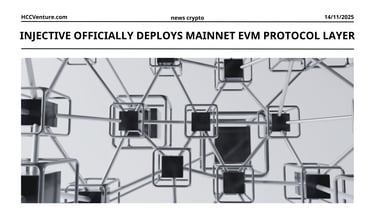Injective officially deploys Mainnet EVM protocol layer - programming environment
Injective activates the native EVM Mainnet, ushering in a new era of seamless Ethereum compatibility on the Cosmos platform and enabling developers to deploy Solidity.
11/14/20252 min read


EVM on Injective - MultiVM unlocked
The EVM Mainnet activation, detailed on Injective's official blog, integrates full support for the Ethereum Virtual Machine directly into the core of the chain, allowing developers to port dApps from Ethereum or Polygon without bridges or wrappers—leveraging CosmWasm for parallel execution and Injective's custom sequencer for 1ms latency.
Injective's EVM mainnet serves as a dedicated protocol layer for financial applications, optimized for the needs of high-throughput DeFi protocols, trading systems, derivatives products, and institutional-grade infrastructure.
Developers can now:
Deploy Solidity contracts directly on Injective.
Access multi-chain liquidity through connections to the Cosmos IBC, Ethereum, and Solana ecosystems.
Build next-generation DeFi platforms like on-chain order books, lending platforms, structured products, and stablecoin protocols — all within a unified execution layer.
The EVM mainnet supports full Ethereum compatibility, meaning existing projects can migrate without modifying their codebase. This significantly reduces integration friction while expanding Injective's developer base and liquidity depth.
From DeFi Darling to Programming Environment
The EVM Injective layer is designed around performance, composability, and financial-grade reliability — three core principles that set it apart from other Layer 1 and Layer 2 EVMs.
Ultra-Low Latency: Injective achieves sub-second block processing times and instant finality, essential for high-frequency and derivatives trading dApps where every millisecond matters in capital efficiency.
Gas Optimization: By leveraging Injective's Cosmos-SDK platform and Tendermint consensus mechanism, the EVM layer offers up to 90% lower gas fees than the Ethereum mainnet, while still maintaining the integrity of EVM execution.
Cross-Chain Interoperability: The EVM layer integrates IBC (Inter-Chain Communication), allowing assets and data to move flexibly between Injective and other ecosystems such as Osmosis, Cosmos Hub, and Axelar, while maintaining direct connections to Ethereum and Solana.
Oracle and Data Infrastructure: Injective's EVM Mainnet supports Oracle integrations from Chainlink, Pyth, and Chronicle, providing developers with reliable price feeds to support on-chain trading and synthetic markets.
Evaluation and Conclusion
Injective's expansion into EVM compatibility follows a broader industry trend where interoperability and composability are becoming key competitive advantages. While networks like Avalanche, Solana, and Near have built EVM-compatible layers, Injective's finance-first architecture and on-chain order book model give it a unique position.
By combining the execution speed of Cosmos with the developer accessibility of Ethereum, Injective effectively bridges two major blockchain ecosystems – ushering in a new wave of cross-chain financial innovation.
Disclaimer: The information presented in this article is the author's personal opinion in the cryptocurrency field. It is not intended to be financial or investment advice. Any investment decision should be based on careful consideration of your personal portfolio and risk tolerance. The views expressed in this article do not represent the official position of the platform. We recommend that readers conduct their own research and consult with a professional before making any investment decisions.
Explore HCCVenture group
HCCVenture © 2023. All rights reserved.


Connect with us
Popular content
Contact to us
E-mail : holdcoincventure_contact@hccventure.com
Register : https://linktr.ee/holdcoincventure
Disclaimer: The information on this website is for informational purposes only and should not be considered investment advice. We are not responsible for any risks or losses arising from investment decisions based on the content here.


TERMS AND CONDITIONS • CUSTOMER PROTECTION POLICY
ANALYTICAL AND NEWS CONTENT IS COMPILED AND PROVIDED BY EXPERTS IN THE FIELD OF DIGITAL FINANCE AND BLOCKCHAIN BELONGING TO HCCVENTURE ORGANIZATION, INCLUDING OWNERSHIP OF THE CONTENT.
RESPONSIBLE FOR MANAGING ALL CONTENT AND ANALYSIS: HCCVENTURE FOUNDER - TRUONG MINH HUY
Read warnings about scams and phishing emails — REPORT A PROBLEM WITH OUR SITE.
